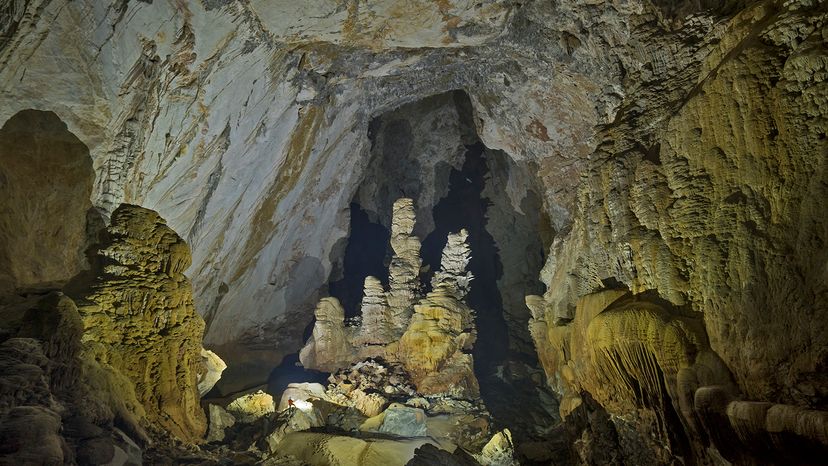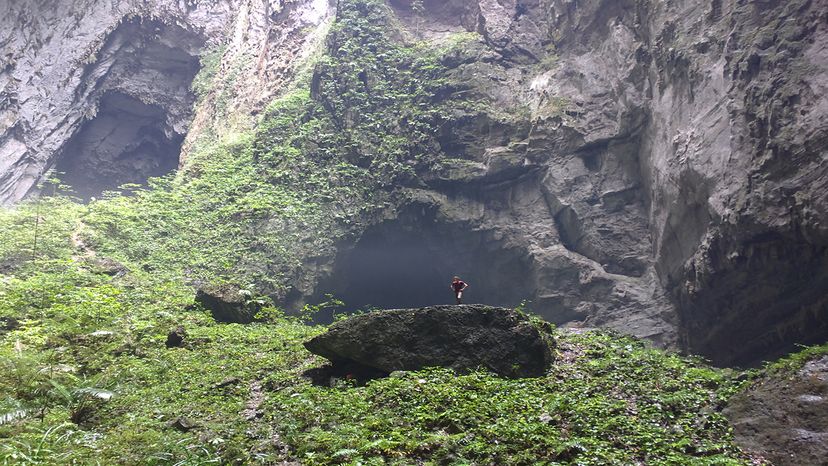
Here's a helpful earth science mnemonic. Stalactites and stalagmites are both cave features created by mineral deposition. The former dangle, the latter ascend. Or, put another way: A stalactite holds on tight to the ceiling of a cave, whereas a stalagmite might touch the ceiling.
And in a remote Vietnamese cave, a stalagmite might also grow to be over 246 feet (75 meters) tall. Fancy that.
Advertisement
The cave we're referencing is called Hang Sơn Đoòng. Located in Vietnam's Phong Nha – Kẻ Bàng National Park, it's over 5.5 miles (8.8 kilometers) long overall. That makes Hang Sơn Đoòn one of the biggest caves on the planet.
Within this subterranean world, there's an especially large passage measuring a bit less than 4 miles (6.5 kilometers) in length. A 2011 paper published by the American Geophysical Union (AGU) describes "continuous widths" of around 328 feet (100 meters) inside. At certain points, the yawning cavity is over 656 feet (200 meters) high from floor to ceiling.
Not only is Hang Sơn Đoòng enormous in scale, but it's also got a surprising amount of biodiversity.
Local man Ho Khanh discovered the cave in 1990; he went on to guide the 2009 expedition which first mapped it out. Anyone with an internet connection can "see" the place for themselves now; head to National Geographic's official website for a virtual 360-degree tour of the geologic marvel. No passport? No problem.
Should you take this digital tour – or join a physical one – you will most definitely notice two giant holes in the roof of Hang Sơn Đoòng. These are dolines, spots where the cave's ceiling collapsed after failing to support its own weight.

The openings have allowed trees, bushes and other plants to thrive on Hang Sơn Đoòng's floor, creating an underground environment reminiscent of Jules Verne's science fiction masterpiece, "Journey to the Center of the Earth."
Below the cave's first major doline, there's a forested space called "Watch Out for Dinosaurs" because of its primordial appearance.
Monkeys, birds and snakes, among other (non-extinct) creatures, populate the greenery. We're sad to say you won't find any Velociraptor lurking down there. But if it's fossils you're after, the remains of prehistoric corals from the carboniferous period – which lasted between 359 and 299 million years ago – have been sighted near "Watch Out for Dinosaurs."
The second major doline is larger than the first, about 535 feet (163 meters) across. It provides sunlight for another mini jungle in the bowels of Hang Sơn Đoòng, a paradise nicknamed the "Garden of Edam." Here, the foliage stands tall, with native plants colonizing a rock pile that was left behind when the cave ceiling fell.
Geologists think Hang Sơn Đoòng is somewhere between two and five million years old. Ancient river water carved this cave into existence – and to this day, a powerful river runs through it.
"The river here is not a pleasant knee-deep stroll in a river valley, but rather a fast flowing river very deep in places with many noisy fast flowing rapids," reads that AGU paper. Better tread carefully.
HowStuffWorks may earn a small commission from affiliate links in this article.
Advertisement